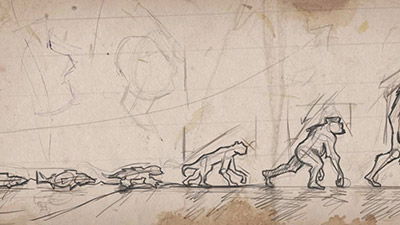
Read the Fine Print—A Preliminary Comment on Saturday’s “Missing Link” Claim in Ethiopia
Researchers working in Ethiopia declared over the weekend that they have discovered “the skull of a small human ancestor that could be a missing link between the extinct Homo erectus and modern man.”
The first thing people should notice whenever they read stories about new evidence of man’s supposed ancestors found in Africa (i.e., something between humans and their alleged ape-like ancestors) is to carefully note the words used in the text of the stories, and not heed their sensational headlines. (For example, ABC-TV News in the USA trumpeted: “Scientists Find Skull of Human Ancestor.”1)
Researchers working in Ethiopia declared over the weekend that they have discovered “the skull of a small human ancestor that could be a missing link between the extinct Homo erectus and modern man”2 (emphasis added). The skull is nearly complete and supposedly dates at between 500,000 and 250,000 years ago, and is essentially human (with some facial features that appear to make it different from modern man, though).
When you get past a confident headline like ABC’s, however, then you eventually read some quite unconfident words.
When you get past a confident headline like ABC’s, however, then you eventually read some quite unconfident words (such as the word “could” in the sentence above). Other examples of cautious wording in the ABC/Associated Press article include: “many believe,” “is thought to have,” “dates to a time about which little is known” and “might prove.” Then there are comments like: “… forces us to re-examine our views of human origins,” which merely demonstrates that the previous certainty held by evolutionary scientists about human origins must now be re-considered.
What have scientists really found? Of course, a creationist researcher will not be allowed access to study this skull; creationists thus will have to rely on examining future scientific papers before making confident comments themselves (and not rely just on a news-release summary composed by the researchers in Ethiopia, which is sketchy3). At the moment, AiG is largely commenting on second-hand reports until any scholarly paper is produced. We may comment again after that research paper appears, but for the moment, we want to point out the cautious wording inside the news items that is lacking in some headlines. Sadly, it’s the headlines that are most remembered, and now many more people around the world will believe that a “missing link” has been found, one which supports the agenda of secular evolutionists who want to show that man is not created specially by God and thus His Word in Genesis is not reliable.
We also need to be reminded of what creationists have been saying about Homo erectus skeletons. For instance, this is what we have posted to this website: “Homo erectus—many remains of this type have been found around the world. They are smaller than the average human today, with an appropriately smaller head (and brain size). However, the brain size is within the range of people today and studies of the middle ear have shown that Homo erectus was just like us. Remains have been found in the same strata and in close proximity to ordinary Homo sapiens, suggesting that they lived together.”4 (There are other articles on this site concerning Homo erectus—just do a search and read the articles you are interested in.)
If Homo erectus was human, then something that is said to be between Homo erectus and Homo sapiens (modern man) would obviously have been human, too. Because the human gene pool was split up at the time of the Tower of Babel (Genesis 11), one would expect to see a range of differences (all within the human range) in the various people groups that were isolated from each other—just as one sees in Homo erectus, Homo neanderthalensis, and Homo sapiens.
The other thing to consider here concerns the dating of this new fossil. Creationists continually point out that the dating methods used to date such fossils are all based on fallible assumptions and therefore are unreliable (see our Radiometric Dating page for more information).
Because secular scientists believe in molecules-to-man evolution and trust the dating methods used to support their evolutionary ideas concerning time, they will continue to interpret such discoveries in terms of man’s supposed evolution from apelike ancestors. However, nothing in observational science (observable and repeatable) has ever contradicted the Bible’s account of man’s origin—that the first man was made from dust around 6, 000 years ago.
Footnotes
- http://abcnews.go.com/International/wireStory?id=1768391 (based on an Associated Press story). See all footnotes
- http://abcnews.go.com/International/wireStory?id=1768391 (based on an Associated Press story). See all footnotes
- The project’s news release is at http://www.stoneageinstitute.org/news/gawis_hominid.pdf. See all footnotes
- Is There Really Evidence that Man Descended from the Apes? See all footnotes
Recommended Resources

Answers in Genesis is an apologetics ministry, dedicated to helping Christians defend their faith and proclaim the good news of Jesus Christ.
- Customer Service 800.778.3390
- © 2025 Answers in Genesis








